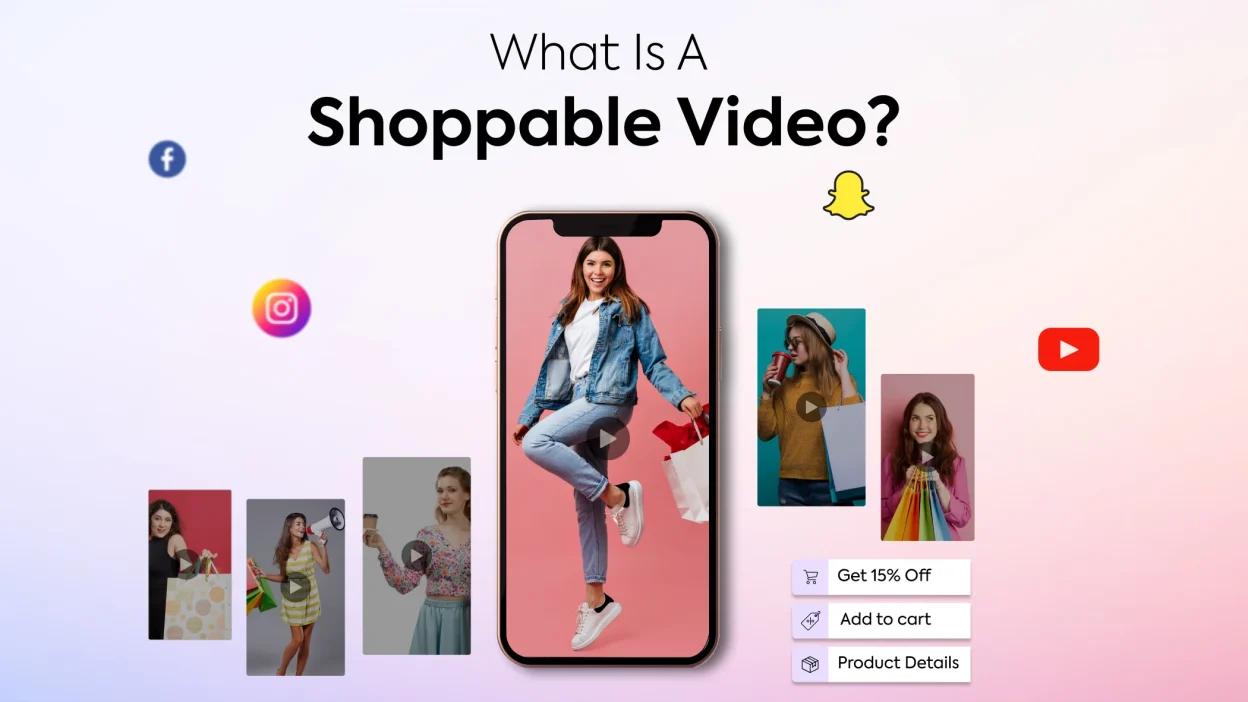Introduction
In the dynamic world of digital marketing and e-commerce, shoppable video contents has emerged as one of the most powerful innovations for brands and retailers looking to bridge the gap between inspiration and action. By embedding direct purchase options within engaging video formats, shoppable videos transform passive viewers into active customers in real time, enabling a seamless, interactive, and frictionless buying journey. With the explosion of short-form video content on platforms like Instagram, TikTok, YouTube, and even on independent brand sites, the ability to transform attention into revenue by integrating clickable, purchasable moments represents a quantum leap in the way people discover, experience, and ultimately buy products online.
The Rise of Shoppable Video: Context and Drivers
The proliferation of smartphones, faster mobile internet, and the cultural shift toward consuming content in bite-sized, visually rich formats have fundamentally changed the way consumers engage with brands and products. Traditional advertising has increasingly become less effective as audiences develop ad blindness and crave more authentic, entertaining, and interactive experiences. Video, by its very nature, tells stories that foster emotional connections and allows for dynamic product demonstrations, unboxing moments, influencer testimonials, and lifestyle scenarios.
Shoppable video content takes this a step further by embedding interactive hotspots, “buy now” buttons, and product tags directly within the video stream. This means viewers can instantly learn more, add to cart, or check out the featured item without ever leaving the video player. This reduces purchase friction and taps into the user’s impulse, significantly boosting conversion rates and average order values.
The shift towards shoppable video is also driven by changing consumer expectations. Modern shoppers—especially Millennials and Gen Z—expect immediacy, personalization, and convenience at every touchpoint. The success stories of global brands and marketplaces leveraging shoppable video to turbocharge their digital sales have established it not just as a trend, but as an essential component of the omnichannel commerce strategy.
Anatomy of a Shoppable Video Experience
Successful shoppable video content blends entertainment and commerce in a way that feels natural, non-intrusive, and value-driven. The core elements of an effective shoppable video include:
- Storytelling: The video unveils a narrative or scenario where products appear organically—be it a fashion haul, DIY tutorial, beauty routine, recipe, or home makeover.
- Interactive Elements: At key moments, clickable hotspots, popups, product carousels, or sidebars are overlaid on the video stream, highlighting featured products.
- Product Details: Viewers can access quick product overviews, sizes, colors, and prices directly from the video interface without pausing or leaving the experience.
- Instant Purchase or Save: A “Buy Now” or “Add to Bag” button, seamlessly integrated, lets users proceed to purchase or save items for later, streamlining the path to conversion.
- Social Proof and Community: Many shoppable videos leverage likes, shares, comments, and even live chat elements to foster trust and encourage action through communal engagement.
- Cross-Platform Functionality: The same shoppable video can be leveraged across owned e-commerce sites, mobile apps, social media channels, email campaigns, and even digital out-of-home displays, creating multiple revenue touchpoints.
How Shoppable Video Drives Conversion
At the heart of shoppable video’s effectiveness is its ability to collapse the traditional purchase funnel into a single, interactive moment. Where once a consumer might have watched a video, opened a new tab, searched for the product, navigated through an e-commerce site, and made a purchase, shoppable video compresses all of these disparate interactions into a unified, frictionless experience.
- Reduced Drop-Offs: By allowing customers to engage with and buy products within the video itself, brands can reduce the typical drop-off points that occur when users must switch apps or tabs, fill out unnecessary forms, or get lost navigating complex sites.
- Impulsive Purchases: Seeing a desirable product in action creates immediate desire. Shoppable video leverages this emotional response with “instant buy” features that capitalize on the shopper’s peak interest.
- Higher Engagement: Interactive videos hold attention ~4x longer than static, non-shoppable videos. The more time spent, the greater the affinity and intent to purchase.
- Informed Decision-Making: As viewers get to see the product in real contexts—how it looks, moves, is used, or styled—they gain confidence in their purchase, reducing returns and increasing satisfaction.
- Social Commerce Synergy: The shareability of video amplifies reach. When a single video can generate both viral engagement and measurable sales, brands maximize ROI from every marketing dollar spent.
Technology Behind Shoppable Videos
To deliver these experiences, several technologies work behind the scenes:
- Interactive Video Layers: HTML5 layers or platform-specific APIs allow for overlaying clickable elements without impacting the original video quality. These are mobile-optimized, responsive, and often personalized based on user data.
- E-Commerce Platform Connectivity: Shoppable videos are integrated with popular commerce platforms, inventory systems, or payment gateways using robust APIs, enabling real-time product availability and streamlined checkout.
- Analytics and Tracking: Advanced analytics record which products are clicked, which moments drive the greatest engagement, drop-off points, heatmaps of interaction, and detailed conversion attribution to continually optimize content and design.
- AI and Personalization: Machine learning recommends products based on user behavior, previous purchases, or predictive intent, further personalizing the shoppable video experience.
- Live Streaming Capability: With the growing popularity of live commerce, platforms now offer real-time video commerce, letting hosts interact with viewers, answer questions, and promote limited-time deals that viewers can act on instantly.
Use Cases Across Industries
1. Fashion and Beauty: Influencers or brand reps showcase try-ons, tutorials, or seasonal lookbooks. Viewers tap the screen to pull up featured items, see different colorways, and purchase instantly, often with exclusive live discounts.
2. Food and Beverage: Recipe videos demonstrate ingredient use, cooking tips, and finished dishes. Shoppable overlays let audiences buy the full bundle of featured ingredients or utensils directly.
3. Consumer Electronics: Product demo videos allow viewers to click on specific features, watch explainer pop-ups, or immediately place an order for the newest gadgets.
4. Home Decor: Virtual room makeovers offer tags on every item in the room, so viewers can shop by style or theme, assembling their cart as they watch.
5. Health and Fitness: Live or recorded workout videos showcase gear or supplements, all available instantly through on-screen links, eliminating the need to search elsewhere.
6. Automotive: Virtual test drives or walkarounds of vehicles let potential buyers interact with specs, book test drives, or configure their own models without leaving the video.
7. Media and Publishing: Authors, musicians, or content creators can promote new releases via video with integrated “shop now” features for merchandise, tickets, or exclusive content.
Implementing Shoppable Video: Best Practices
Creating shoppable video content that performs requires a blend of creativity, technology, and user experience design. Consider the following best practices:
- Seamless Integration: Interactive elements must feel like a natural part of the viewing experience—never intrusive or distracting.
- Fast Loading and Mobile First: Optimized for quick load times and responsive to all screen sizes, ensuring a smooth experience on any device.
- Clear CTAs: “Buy Now,” “Details,” and “Add to Cart” buttons should be easily visible, actionable, and contextually triggered at relevant moments.
- High Production Value: Even as short-form content flourishes, video quality matters. Clear visuals, great sound, and compelling storytelling boost engagement and trust.
- Compliance and Privacy: User data captured through video interactions must align with global privacy standards and local regulations.
- A/B Testing and Optimization: Small tweaks to placement, timing, or design of shoppable elements can dramatically improve results. Regular testing is critical.
- Integration With Marketing Stack: Shoppable video should sync with CRM, inventory, analytics, and fulfillment systems for consistent, up-to-date product information and order processing.
- Accessibility: Make sure videos are accessible—captioned for the hearing impaired, with alt tags and keyboard navigation for those with physical disabilities.
Challenges and Considerations
As powerful as shoppable video content is, there are challenges to overcome:
- Technology Fragmentation: Not all platforms natively support shoppable features. Brands may need to use different solutions for their own site, Instagram, TikTok, and YouTube.
- Design Balance: There’s a delicate line between convenience and clutter—too many clickable elements can overwhelm the viewer, undercutting the intended impact.
- Attribution Complexity: When videos are shared across multiple channels or go viral, accurately tracking which views translated to sales can be tricky.
- Content Creation Demands: High-performing shoppable videos often require significant creative resources, including talented video producers, editors, and marketers.
- Inventory Synchronicity: Real-time integrations with inventory and fulfillment systems are necessary to prevent negative experiences like promoting out-of-stock items.

The Future of Shoppable Video
The trajectory of shoppable video content is only pointing upward:
- Integration With AR and VR: The next wave will let users interact with virtual products in real-time—try on clothing or shoes virtually, visualizing furniture in their living room, or seeing makeup on their own face—all within a shoppable video stream.
- Expanded Live Commerce: Brands are leveraging live streaming—once limited to Asia’s e-commerce giants—on a global scale, driving urgency and excitement during product drops and limited edition releases.
- Interactive Storytelling: Multiple-choice narratives and “choose-your-own-adventure” video shopping experiences will become widespread, allowing viewers to select outcomes, styles, or experiences as they shop.
- Voice-Activated Shopping: As voice AI and smart devices proliferate, viewers will be able to shop via simple vocal commands while consuming video content.
- Deeper Personalization: Leveraging user data, AI-driven recommendations will show only the most relevant products to each viewer, increasing the likelihood of conversion.
Measuring Success: Key Metrics and KPIs
To gauge the effectiveness of shoppable video content, brands look at:
- Click-Through Rate (CTR): Percentage of viewers who interact with product links or buttons.
- Conversion Rate: Proportion of video viewers who make a purchase during or after watching.
- View Duration and Engagement: Time spent watching, re-watches, and participation in comments or live interactions.
- Order Value: Changes in average basket size when shoppers use video-driven features.
- Attribution Tracking: Linking specific video moments and channels to sales and downstream brand impact.
Real-World Impact: Case Examples
Major retailers and disruptors—from beauty brands to mass merchants—have seen dramatic lifts in engagement, conversion, and order size after deploying shoppable video content. Influencer unboxings now routinely generate instant sell-outs, and product launches leveraging live video shopping see hundreds of thousands of concurrent viewers making purchases in real time. Small businesses, too, leverage affordable tools to create interactive product demos that drive sales with a fraction of the traditional marketing budget. The democratization of video commerce technology means even niche brands can compete with global players by creating authentic, shop-enabled video journeys tailored to their unique audiences.
Conclusion
In a digital environment where consumer attention is precious and competition is fierce, shoppable video content stands out as a transformative force that empowers brands, creators, and retailers to turn inspiration into instant action. By reducing friction in the purchase journey, bringing product discovery and fulfillment into one immersive experience, and leveraging the power of storytelling, shoppable videos redefine what it means to shop online. As technology continues to evolve and consumers become ever more comfortable with interactive commerce, the future belongs to those who put engaging, actionable video at the core of their digital strategy—converting viewers not just into customers, but into lifelong fans and brand advocates.





